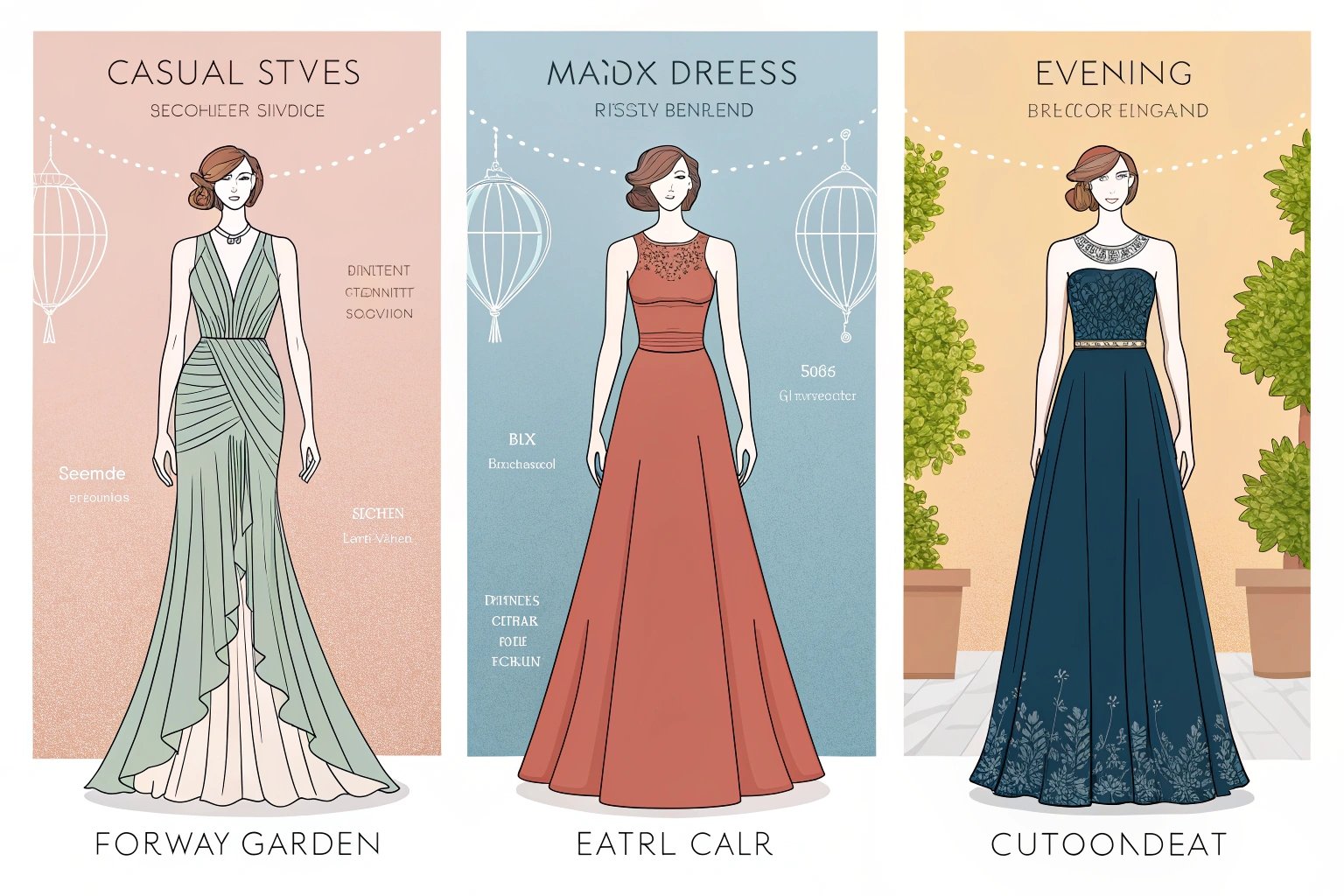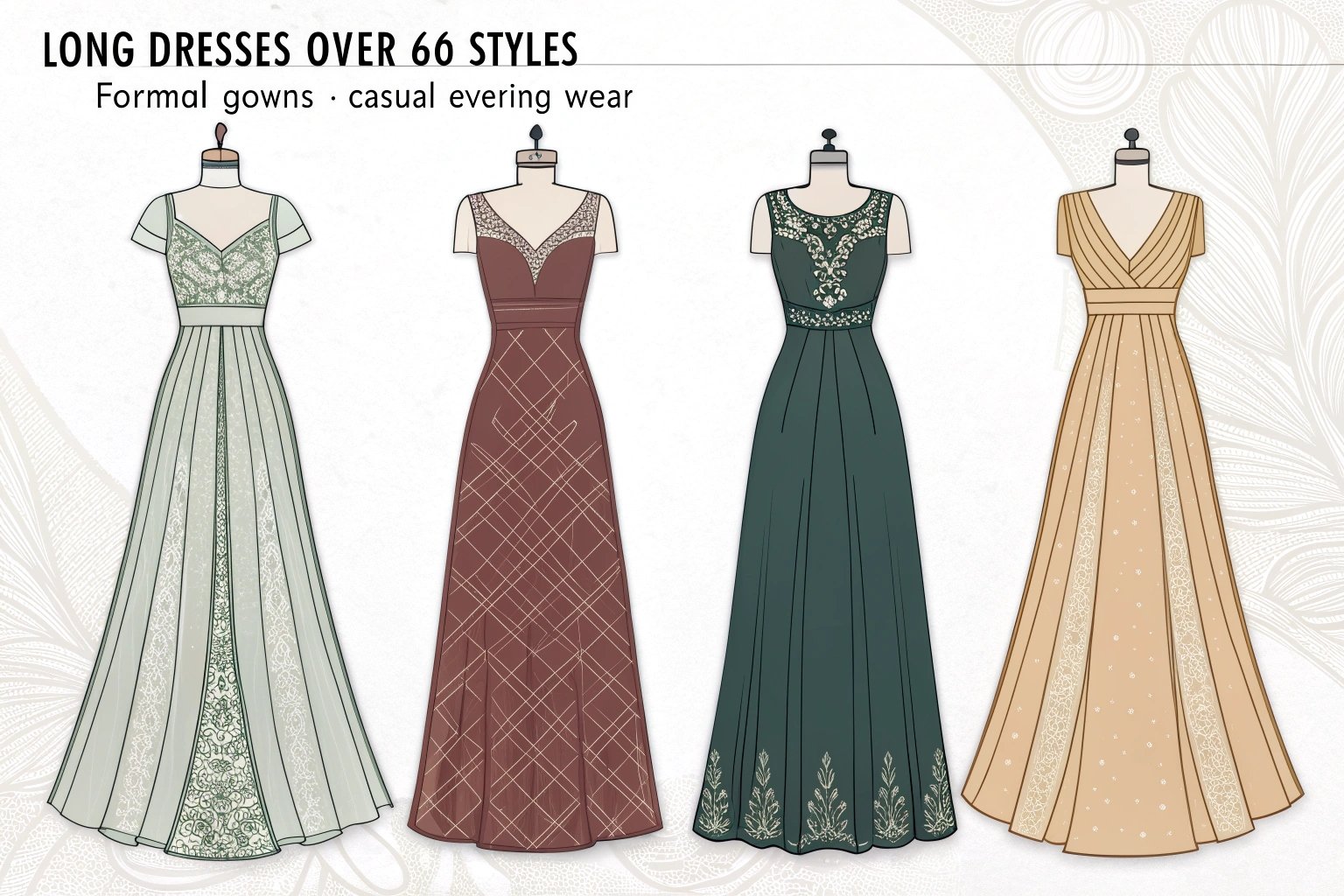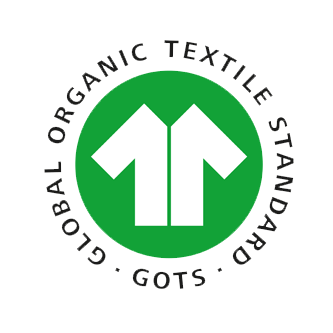After laying the foundation in Part 1 with sleeve constructions, and expanding into aesthetic and functional sleeve types in Part 2, we now shift our focus to the strategic application of sleeve design across different fashion categories.
In Part 3, we’ll examine how specific sleeve types serve varied product types—from casual tops and formal dresses to outerwear and swimwear. This chapter will also explore how buyers can select sleeve types based on demographics, seasonality, and production scale. For brands balancing creativity with cost-efficiency, understanding how to match sleeves with use-cases ensures smarter sampling and more profitable collections.
Leg of Mutton Sleeve
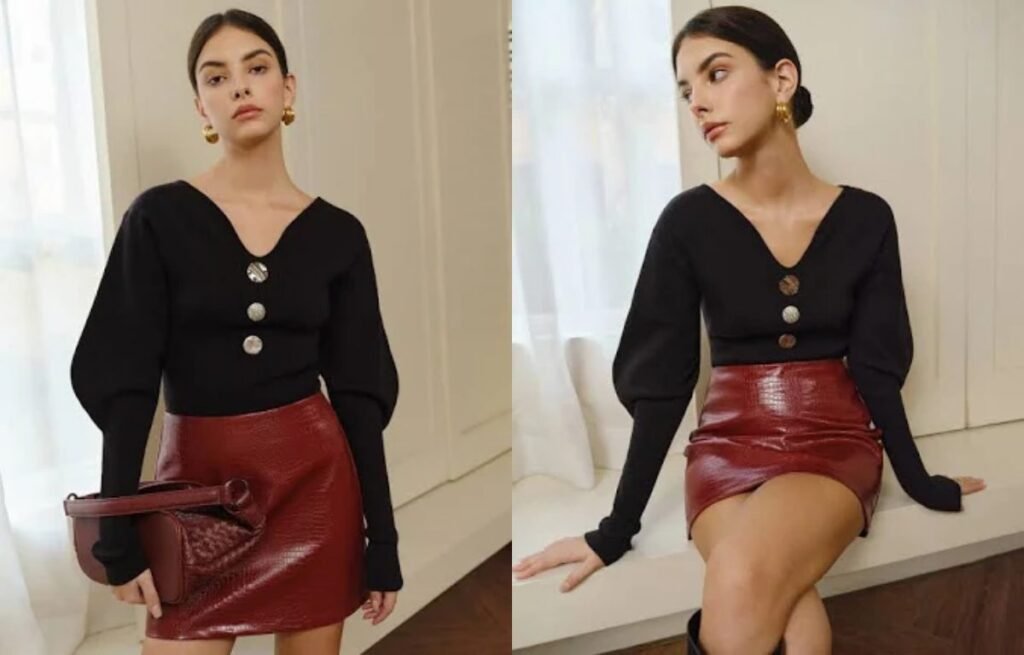
Leg of mutton sleeves, also called gigot sleeves, are characterized by their voluminous upper arm that gradually tapers to a fitted lower arm or cuff. This sleeve adds height, statement volume, and a distinct silhouette that draws attention.
I used this sleeve in a structured mini dress for a fashion-forward client—the strong shoulder instantly gave it a runway-ready impact.
How is the leg of mutton sleeve designed compared to puff or balloon sleeves?
It’s all about dramatic build-up and sharp tapering.
Leg of mutton sleeves are fullest at the upper arm, often extending above the shoulder line, and then narrow sharply toward the elbow or wrist. Unlike balloon or puff sleeves, they focus volume at the top only, creating a more elongated and powerful shape.
This makes them ideal for designs where you want to emphasize the shoulders or create a contrast with a slim silhouette.
Style comparison:
| Feature | Leg of Mutton Sleeve | Puff Sleeve | Balloon Sleeve |
|---|---|---|---|
| Volume Placement | Upper arm and shoulder | Top and bottom | Mostly full length |
| Tapering | Strong taper to wrist | May or may not taper | Often gathered at hem |
| Design Impact | Bold, structured | Soft, rounded | Voluminous and playful |
What fabrics are best suited for leg of mutton sleeves?
Structure is key to holding the upper volume.
Medium to heavy fabrics like taffeta, organza, cotton sateen, and crisp poplin are ideal. These materials maintain the sculptural shape at the top while tapering smoothly toward the wrist. Lightweight fabrics need internal support to hold the structure.
In one high-impact eveningwear piece, I used layered organza for a sculpted leg of mutton sleeve—it held the volume perfectly without being heavy.
Recommended fabrics:
- Taffeta
- Crisp poplin
- Cotton sateen
- Organza (with inner lining)
- Lightweight denim (for bold street styles)
Which garments and customers are best suited for this sleeve style?
Great for statement pieces and fashion-forward collections.
Leg of mutton sleeves are ideal for evening dresses, editorial tops, structured blouses, and outerwear. They appeal to buyers seeking vintage-inspired silhouettes or bold runway looks with modern twists.
They’re particularly effective for brands aiming to blend femininity with strength and drama.
Best applications:
- Couture-inspired mini dresses
- High-shouldered blouses
- Statement evening tops
- Retro-modern coats or jackets
French Court Sleeve
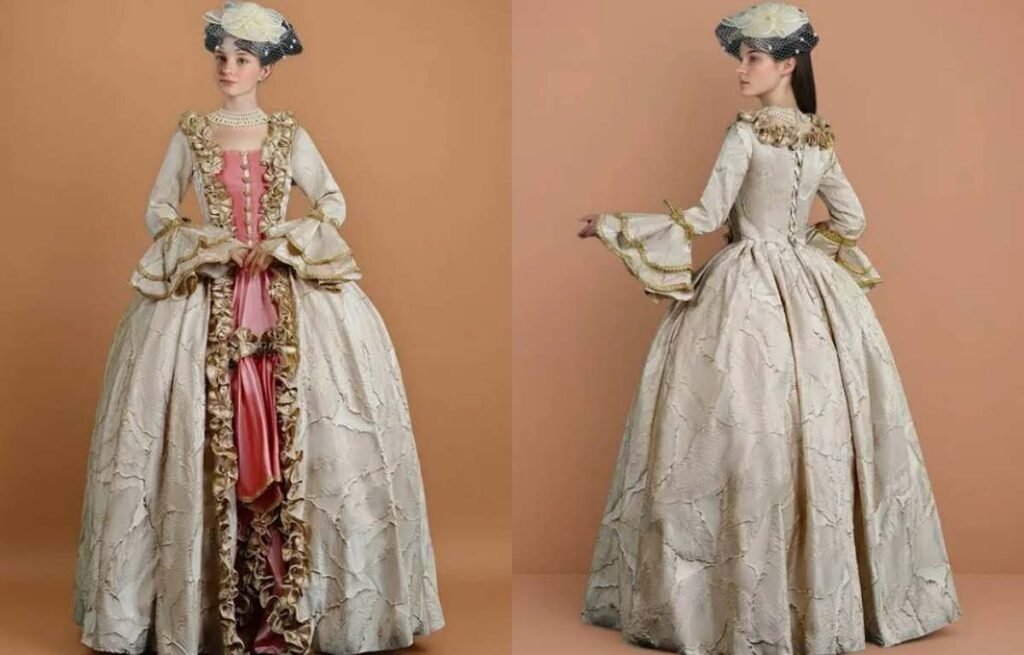
French court sleeves are elaborate sleeves inspired by 17th and 18th-century European fashion. They typically feature multiple layers of ruffles or flounces at the elbow or wrist, creating a regal, dramatic, and highly decorative look.
I once included French court sleeves in a formal capsule collection—the piece felt instantly luxurious and turned heads at every showing.
How are French court sleeves constructed compared to other layered sleeve styles?
It’s about historical layering with a structured silhouette.
French court sleeves are usually long and fitted from shoulder to elbow, then flared dramatically with tiered ruffles or lace at the forearm. Unlike flared or trumpet sleeves, these often include gathered inserts or contrasting fabrics for visual richness.
They are inspired by aristocratic gowns but can be modernized for today’s eveningwear and editorial fashion.
Comparison table:
| Feature | French Court Sleeve | Trumpet Sleeve | Tiered Sleeve |
|---|---|---|---|
| Structure | Fitted upper, ruffled end | Fitted then flared subtly | Layered in visible tiers |
| Style origin | Historical / aristocratic | Modern minimal or retro | Trendy and youthful |
| Key detail | Elaborate lace or frills | Clean flare | Multiple fabric layers |
What fabrics are best for creating French court sleeves?
Delicate layers need both structure and softness.
Lightweight fabrics with crisp edges like organza, lace, tulle, or light silk work well for the ruffled portion. The fitted section often uses satin, brocade, or lightweight woven blends to hold shape.
In one design, I used satin for the upper sleeve and sheer embroidered lace for the ruffle—classic and editorial at once.
Recommended fabrics:
- Satin or silk
- Organza
- Tulle
- Lace
- Lightweight brocade
Best applications:
- Evening gowns
- Romantic editorial dresses
- Bridal or bridesmaid fashion
- Couture tops and blouses
Power Sleeve
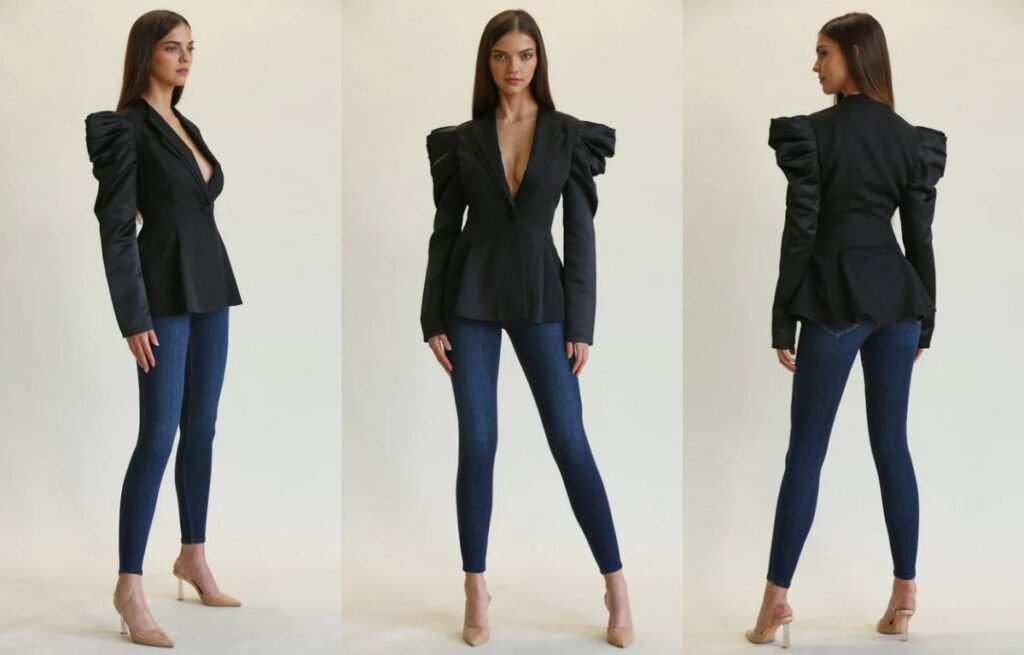
Power sleeves are exaggerated sleeve styles with strong volume, usually at the shoulder or upper arm. They’re designed to make a visual impact—symbolizing strength, confidence, and fashion-forward thinking.
I once created a structured power sleeve blouse for a brand’s editorial collection—it transformed a simple top into a runway-ready piece.
How are power sleeves constructed differently from regular puff or structured sleeves?
It’s not just volume—it’s controlled drama.
Power sleeves are built with defined shape, often using tucks, pleats, padding, or stiff fabric to maintain structure. Unlike soft puff sleeves that collapse easily, power sleeves are sculpted to stand tall and sharp, especially at the shoulder.
The aim is to enhance the silhouette while creating presence and attitude.
Style comparison:
| Feature | Power Sleeve | Puff Sleeve | Structured Sleeve |
|---|---|---|---|
| Volume location | Mostly at shoulder | Top or bottom | Tailored, minimal |
| Shape retention | High—uses interfacing/padding | Low—soft gathers | Medium—shaped by seams |
| Design impact | Strong and bold | Soft and romantic | Clean and fitted |
What fabrics and materials are best for power sleeves?
Structure is everything—stiffness is essential.
Fabrics like taffeta, cotton poplin, bonded crepe, and organza work best for power sleeves. These materials hold shape and allow designers to exaggerate volume without collapsing. Interfacing and sleeve heads are often used for extra lift.
For a dramatic silhouette, I once used bonded satin with padded sleeve caps—the shoulders were sharp, defined, and unforgettable.
Suggested materials:
- Taffeta
- Bonded crepe
- Cotton poplin
- Organza
- Satin with interfacing
What garments and buyers suit the power sleeve aesthetic?
Perfect for bold, confident fashion.
Power sleeves are ideal for dresses, blouses, jumpsuits, and outerwear in statement collections. They appeal to trend-driven, editorial buyers who want garments that command attention and showcase personality.
This sleeve is especially popular with Gen Z and Millennial shoppers who love high fashion drama in wearable forms.
Best applications:
- Statement evening dresses
- Structured blouses
- Fashion-forward jumpsuits
- Designer jackets and coats
Wing Sleeve
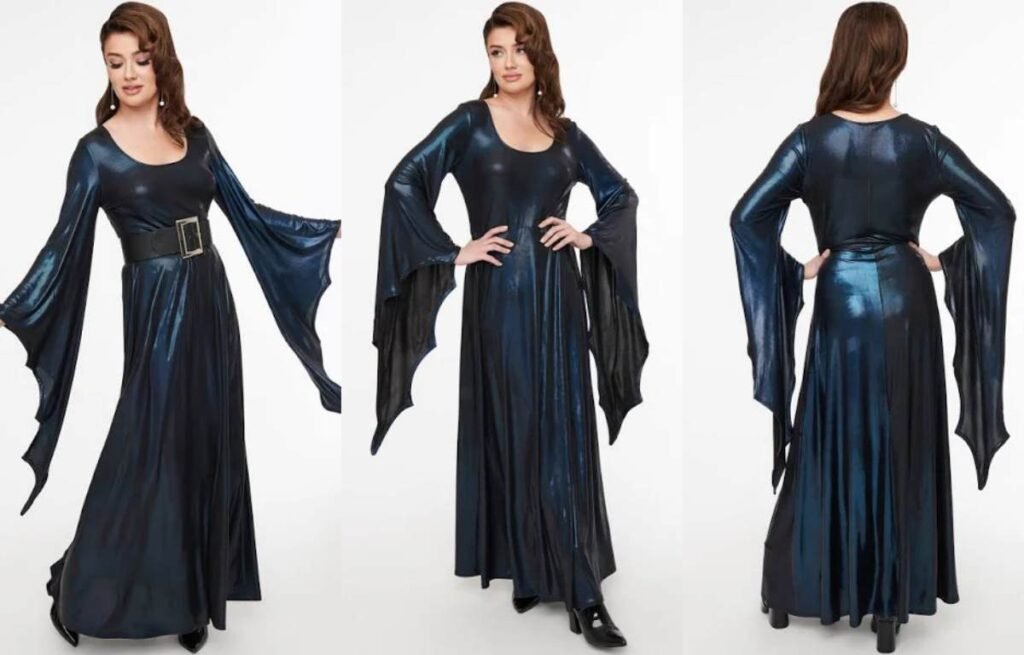
Wing sleeves extend outward from the shoulder or bodice in a flat, wide panel—resembling a bird’s wing. Unlike flutter or cape sleeves, they don’t curve around the arm but instead create a sharp, architectural silhouette.
I once used wing sleeves on a structured crepe top for a runway look—it became the centerpiece of the collection with just that detail.
How do wing sleeves differ from cape or butterfly sleeves?
It’s about shape and direction, not just flow.
While cape and butterfly sleeves drape and move, wing sleeves stay firm and structured. They’re cut to angle outward from the shoulder or upper arm, often with no underarm seam, forming a striking wing-like silhouette.
This gives the design a futuristic or avant-garde edge, often used in high-concept or editorial garments.
Sleeve comparison:
| Feature | Wing Sleeve | Cape Sleeve | Butterfly Sleeve |
|---|---|---|---|
| Shape | Straight and outward | Draped and flowing | Curved and flared |
| Arm coverage | Partial or open | Full upper arm | Partial upper arm |
| Design effect | Sharp and dramatic | Soft and elegant | Light and romantic |
What fabrics work best for wing sleeves?
Stability and structure are essential.
Medium to stiff fabrics like taffeta, scuba, organza, or structured crepe hold the outward wing shape best. Soft fabrics will collapse and lose the intended sharpness.
I once developed wing sleeves using bonded neoprene—it kept the edges crisp and sculptural through multiple wears and washes.
Recommended fabrics:
- Scuba
- Taffeta
- Bonded crepe
- Organza
- Neoprene
What garments and target buyers are ideal for wing sleeve designs?
Great for fashion-forward, editorial pieces.
Wing sleeves work best in statement tops, cocktail dresses, and structured blouses. They appeal to customers who value unique silhouettes, minimal styling, and fashion with a strong presence.
These designs often attract boutique buyers targeting high-fashion or artistic collections with bold shapes.
Best applications:
- Runway tops
- Structured blouses
- Statement dresses
- Sculptural outerwear
Structured Layered Sleeve

Why are structured layered sleeves a bold and elevated feature in modern women’s design?
They deliver volume with control—and make a strong visual impact.
Structured layered sleeves are built with multiple overlapping fabric panels, usually stiffened or shaped, to create a three-dimensional, architectural silhouette. They stand out in any collection due to their bold shape and couture-like appearance.
I once added structured layers to a statement top for a fashion week capsule—it instantly became the most photographed look in the lineup.
How are structured layered sleeves different from tiered or ruffled sleeve styles?
It’s not about softness—it’s about form.
Unlike soft, flowing ruffles or gathered tiers, structured layered sleeves use firm fabric panels arranged in geometric or cascading forms. These layers don’t collapse; they hold shape and create angles or curves based on the design.
They add a sculptural quality that feels more polished and high-fashion than romantic or playful.
Sleeve style comparison:
| Feature | Structured Layered Sleeve | Tiered Sleeve | Ruffle Sleeve |
|---|---|---|---|
| Layer Construction | Defined, firm panels | Flowy gathered layers | Soft, gathered fabric |
| Visual Style | Bold, sculptural | Soft, romantic | Playful, feminine |
| Movement | Minimal | Flowing | Wavy |
What fabrics work best to build structured layered sleeves?
Structure is everything—soft fabrics won’t hold.
Medium to heavyweight fabrics with body and crispness are best—like taffeta, organdy, bonded crepe, or neoprene. These materials hold shapes and edges, keeping the layered design visually intact.
I used bonded crepe in one design to form petal-like sleeve layers that fanned out without collapsing.
Recommended fabrics:
- Taffeta
- Bonded crepe
- Neoprene
- Organza or organdy
- Stiffened poplin (for minimal looks)
Which garments and buyers are best suited for structured layered sleeves?
Perfect for standout pieces in bold, directional collections.
Structured layered sleeves are ideal for runway tops, cocktail dresses, formal jackets, or high-impact statement pieces. Buyers looking for editorial-worthy styles, occasionwear, or avant-garde details will be drawn to this sleeve.
This style works well for limited editions, designer collaborations, or fashion-forward collections.
Best applications:
- Couture-inspired tops
- Evening mini dresses
- Formal suiting with a twist
- Fashion week or lookbook showpieces
Utility Sleeve
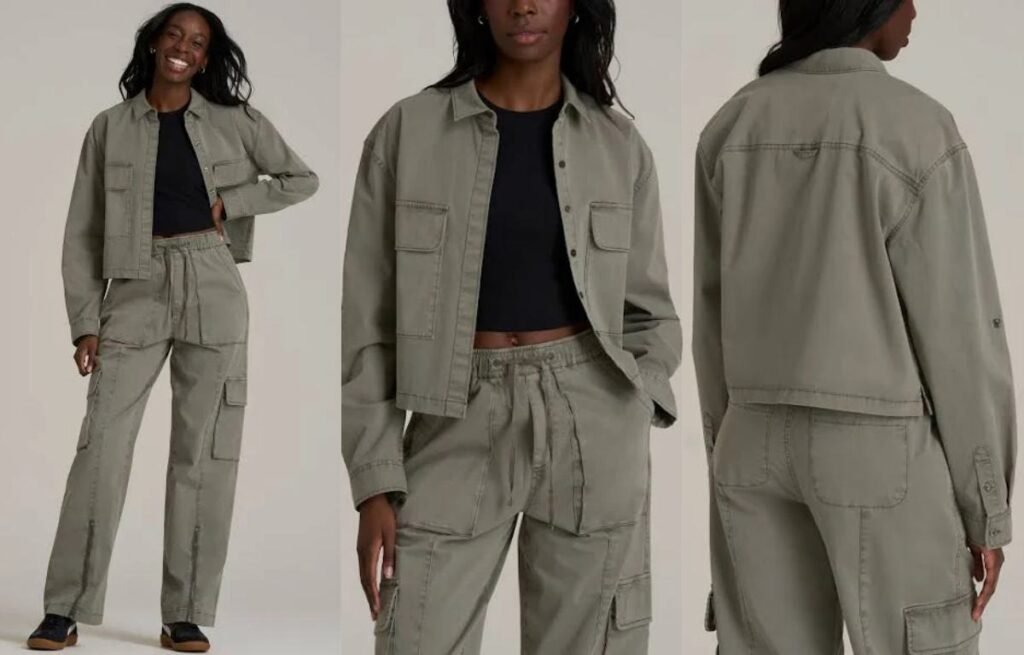
Why are utility sleeves a functional and fashionable choice in women’s fashion design?
They bring structure, practicality, and a touch of rugged style.
Utility sleeves are designed with function in mind—featuring details like tabs, cargo-style pockets, visible stitching, or roll-up straps. These sleeves add a structured, workwear-inspired look to fashion pieces without sacrificing style.
I once added utility sleeves with tab closures to a cotton twill jacket—buyers loved how it looked tough yet wearable.
How do utility sleeves differ from other structured or detailed sleeves?
It’s not just about style—it’s about use.
Utility sleeves typically include functional elements like adjustable cuffs, reinforcement seams, or button tabs. Unlike decorative sleeves, utility sleeves prioritize wearability, often allowing for rolling, adjusting, or securing the sleeve for different activities.
They’re perfect for fashion that blends outdoor influence with urban style.
Comparison table:
| Feature | Utility Sleeve | Classic Shirt Sleeve | Cargo Sleeve |
|---|---|---|---|
| Key Detail | Tabs, roll-ups, seams | Clean, tailored fit | Pockets, flap detailing |
| Focus | Function + form | Simplicity + polish | Storage + volume |
| Style Impression | Rugged, practical chic | Timeless, neat | Oversized, utilitarian |
What fabrics suit utility sleeve designs best?
You need durability with a structured drape.
Medium-weight fabrics like cotton twill, canvas, denim, or tencel blends work best. These fabrics support the construction and keep the details crisp. Lighter fabrics tend to collapse, hiding functional design elements.
In one of our outerwear lines, we used stretch cotton poplin for comfort and form—it held the sleeve tabs and topstitching perfectly.
Recommended fabrics:
- Cotton twill
- Lightweight canvas
- Stretch denim
- Tencel-cotton blends
- Poplin with structure
What garments and buyers benefit most from utility sleeves?
They’re ideal for practical fashion with a street or casual edge.
Utility sleeves are great on jackets, shackets, jumpsuits, and shirt dresses. They appeal to buyers who value functionality and style—perfect for collections inspired by safari, military, or workwear aesthetics.
Especially popular with women who want versatile, day-to-day fashion with attitude.
Best applications:
- Shirt jackets (shackets)
- Utility dresses
- Cargo-style tops
- Casual outerwear
Bomber Jacket Sleeve
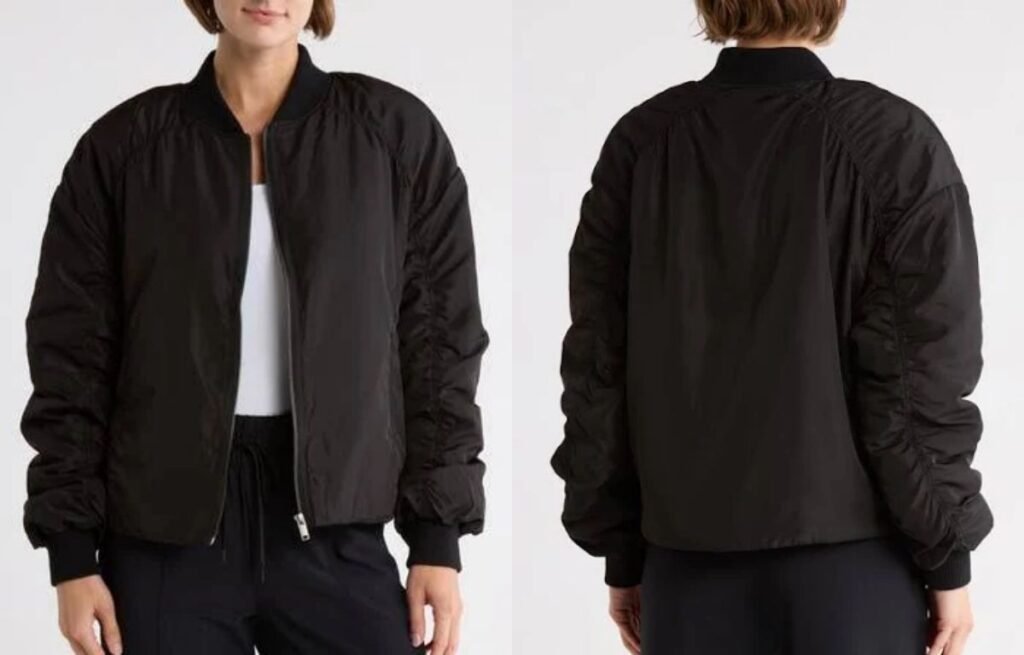
What makes bomber jacket sleeves essential in modern street and casual fashion?
They bring structure, comfort, and attitude—without sacrificing wearability.
Bomber jacket sleeves are typically roomy with dropped shoulders, often gathered at the cuff using ribbed knit or elastic. They create a relaxed, slightly oversized silhouette that’s become a key detail in streetwear and casual outerwear.
I designed a cropped bomber for a client last season—the sleeve shape gave it that effortless, cool-girl energy her customers loved.
How are bomber jacket sleeves different from other jacket sleeves?
It’s all about volume, cuff detailing, and shoulder placement.
Bomber sleeves usually have extra room in the bicep and taper sharply at the cuff. They often feature rib-knit or elastic cuffs and are sewn into a relaxed shoulder seam. This gives the garment a rounded shape that enhances movement and layering.
You’ll rarely see darts or shaping seams in bomber sleeves—the design favors softness over structure.
Comparison chart:
| Feature | Bomber Jacket Sleeve | Blazer Sleeve | Shirt Jacket Sleeve |
|---|---|---|---|
| Shape | Rounded, relaxed | Straight and tailored | Straight, semi-relaxed |
| Cuff type | Elastic or ribbed knit | Button or vented | Button or plain cuff |
| Shoulder construction | Dropped or raglan | Set-in, structured | Slightly dropped or set-in |
What fabrics work best for bomber-style sleeves?
Durability and drape are key.
Nylon, polyester, satin, or twill are classic choices for bomber sleeves. These fabrics support the sleeve’s rounded structure and are easy to line and quilt. For a premium twist, faux leather or heavy knit can be used.
In one design, I combined shiny nylon with ribbed cuffs in a tonal color—it gave the jacket a sleek, athletic-luxury vibe.
Recommended fabrics:
- Nylon or poly satin
- Lightweight twill
- Quilted shell fabric
- Faux leather
- Double-knit fabric
What types of garments and buyers benefit most from bomber jacket sleeves?
Streetwear, athleisure, and casual layers all use this design.
Bomber jacket sleeves are best suited for casual jackets, cropped outerwear, varsity styles, and even streetwear-inspired dresses. They appeal to buyers looking for trendy, oversized silhouettes that feel comfortable and cool.
This sleeve is a go-to for collections targeting Gen Z and urban fashion-forward consumers.
Best applications:
- Cropped bomber jackets
- Oversized varsity outerwear
- Streetwear trench hybrids
- Padded sweatshirts or dresses
Military Sleeve
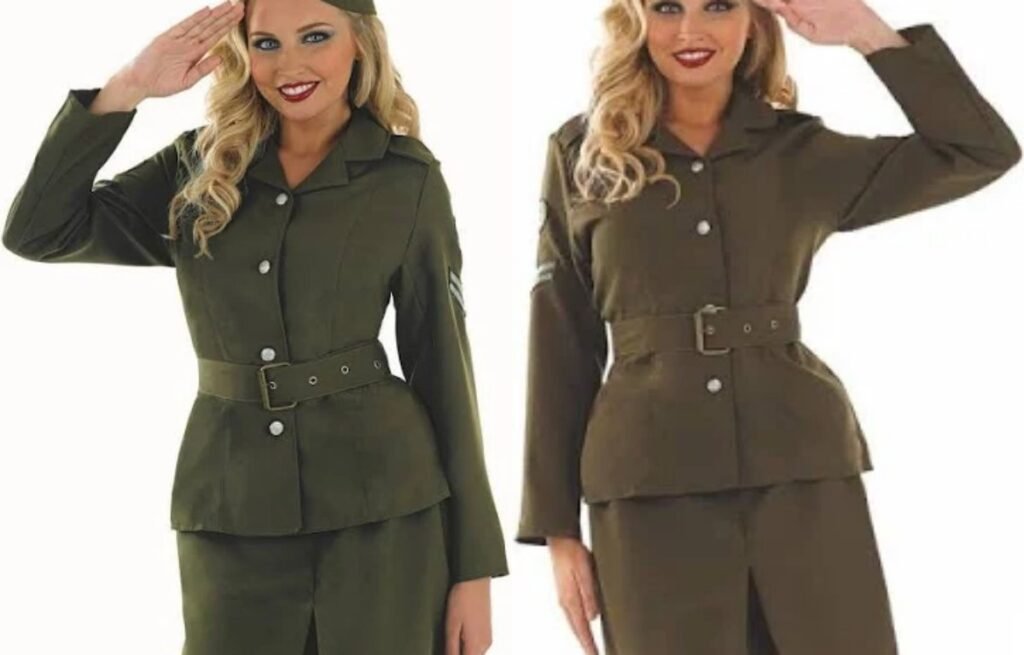
What defines a military sleeve in modern women’s fashion design?
It’s structured, strong, and adds instant authority to any silhouette.
Military sleeves are inspired by uniforms and typically feature structured cuts, shoulder epaulets, button details, and stitched seams. They convey power, order, and functionality—adding a masculine edge to otherwise soft garments.
I once added military sleeves to a trench-style dress for a fall capsule—the piece immediately felt bold, directional, and high-impact.
How are military sleeves constructed differently from other structured sleeve types?
It’s about detail, not just the cut.
Military sleeves usually include tailored shoulder shapes, stitched pleats or panels, and functional or decorative buttons. Many also feature tabs, cuffs, and reinforced seams. These elements create visual structure and a feeling of strength.
This style is often symmetrical, clean, and heavily influenced by utility fashion aesthetics.
Key construction features:
- Buttoned tabs or epaulets
- Reinforced or panelled seams
- Rolled or cuffed finishes
- Shoulder structure with a slight lift
| Feature | Military Sleeve | Shirt Sleeve | Blazer Sleeve |
|---|---|---|---|
| Inspiration | Army uniforms | Classic menswear | Tailored formalwear |
| Visual appeal | Bold and utilitarian | Clean and casual | Sleek and structured |
| Details | Tabs, buttons, pleats | Simple cuffs | Button cuff, plain seam |
What fabrics pair best with military sleeve styles?
You need strength and shape retention.
Medium to heavy fabrics like cotton twill, denim, canvas, and wool blends support the structure and detail work of military sleeves. These fabrics keep pleats crisp and tabs upright while enhancing the sharp silhouette.
In one collection, we used garment-dyed twill with top-stitching—it held the sleeve shape beautifully and elevated the utility look.
Recommended fabrics:
- Cotton twill
- Brushed canvas
- Wool-blend suiting
- Heavy denim
- Bonded jersey (for modern takes)
Which garments benefit most from military sleeves?
Great for outerwear, smart casual, and utility-inspired lines.
Military sleeves are ideal for jackets, trenches, shirtdresses, and structured tops. They suit buyers who appreciate functional fashion with a bold, tailored edge—often seen in fall/winter or workwear collections.
This sleeve type works especially well for fashion brands targeting confident, directional dressers who value structure over softness.
Best applications:
- Utility jackets
- Belted shirt dresses
- Statement wool coats
- Structured button-up tops
Sun Protection Sleeve
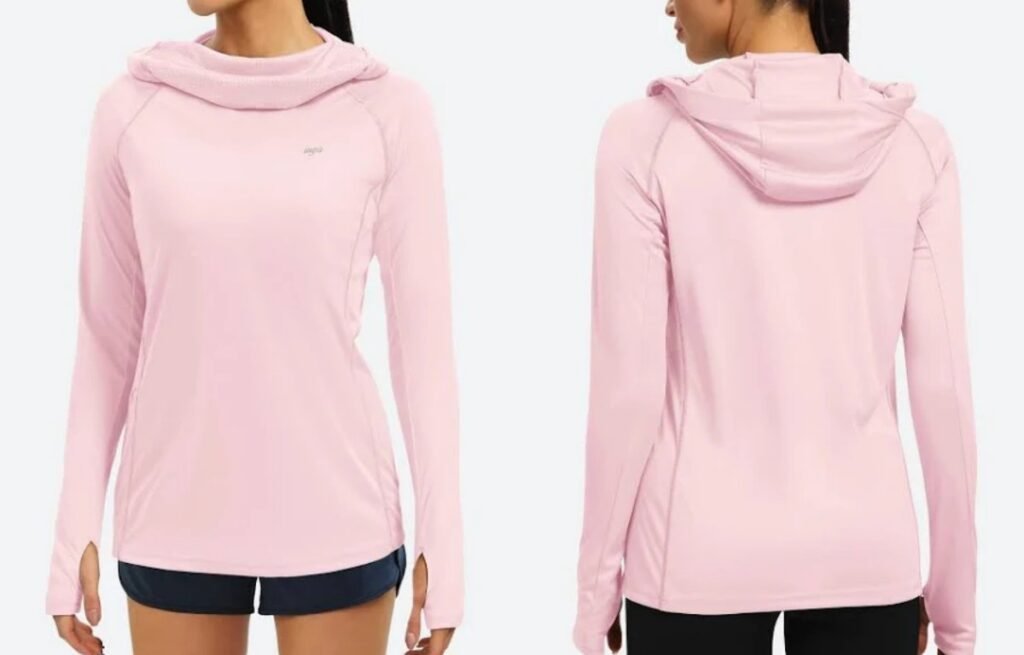
Why are sun protection sleeves an essential feature in modern women’s fashion?
They combine function with fashion—protecting skin without compromising style.
Sun protection sleeves are designed to shield arms from UV exposure, using fabrics with built-in UPF (Ultraviolet Protection Factor). They’re lightweight, breathable, and increasingly integrated into casual, active, and resortwear collections.
I added sun protection sleeves to a summer activewear set for a client—it became a top pick for customers seeking both style and safety outdoors.
What makes sun protection sleeves different from standard long sleeves?
They’re engineered for purpose—not just coverage.
Unlike regular long sleeves, sun protection sleeves use performance fabrics with UPF ratings, moisture-wicking properties, and cooling technology. They’re often slimmer and more flexible, designed to protect without overheating or restricting movement.
This type of sleeve is essential for garments targeting travel, beachwear, and athleisure buyers.
Comparison table:
| Feature | Sun Protection Sleeve | Standard Long Sleeve | Activewear Sleeve |
|---|---|---|---|
| Fabric tech | UPF, moisture-wicking | Regular knit or woven | May include stretch & mesh |
| Comfort level | Lightweight and breathable | Varies by material | Often snug, performance-fit |
| Use case | Outdoor, sun-exposed wear | Everyday or seasonal wear | High-intensity movement |
Which fabrics work best for sun protection sleeves?
Fabric performance is the priority here.
Technical knits like nylon-spandex blends, bamboo jersey, and recycled poly fabrics with UPF ratings are ideal. These materials are breathable, stretchy, and designed to resist UV damage while keeping the skin cool.
For one client, I sourced a recycled UPF50+ jersey that felt smooth, light, and eco-friendly—perfect for a beach-to-town look.
Recommended fabrics:
- Recycled polyester with UPF
- Nylon-spandex blends
- Bamboo or Tencel jersey with UV protection
- Cooling mesh panels (for hybrid designs)
What garments and buyers benefit most from sun protection sleeves?
This design speaks directly to health-conscious, active women.
Sun protection sleeves are commonly found in longline swim tops, activewear, travel dresses, and outdoor gear. They appeal to buyers who prioritize wellness, function, and modern styling—especially in Australia, the U.S., and coastal regions.
It’s a perfect feature for brands offering summer capsules, wellness collections, or beach-to-city looks.
Best applications:
- UPF-rated swim tops or rash guards
- Lightweight active hoodies
- Resort dresses with long sleeves
- Hiking or running tops
Minimal Kimono Sleeve
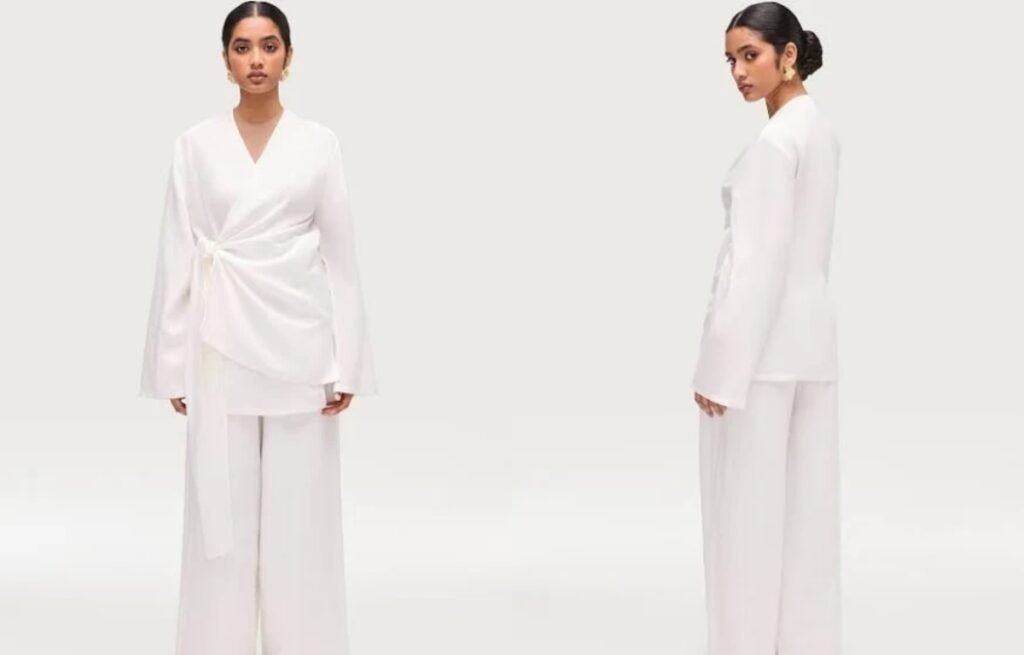
Why are minimal kimono sleeves a staple in clean and modern fashion design?
They offer elegance through simplicity—perfect for streamlined silhouettes.
Minimal kimono sleeves keep the traditional kimono shape but remove the bulk, flare, or wide drape. This results in a sleek, modern sleeve that blends seamlessly into contemporary, minimalist garments.
I once used a minimal kimono sleeve in a soft rayon blouse—the clean lines gave it a refined, high-end look with zero complication.
How do minimal kimono sleeves differ from traditional kimono sleeves?
It’s about less volume and more control.
Traditional kimono sleeves are wide and often extend past the wrist. Minimal kimono sleeves are narrower, shorter, and more tailored. The sleeve is still cut as one piece with the bodice, but the shape is adjusted to hug the arm more closely and maintain a clean silhouette.
Designers love it for pieces that need that relaxed flow—but without overwhelming the body.
Comparison chart:
| Feature | Minimal Kimono Sleeve | Traditional Kimono Sleeve | Set-in Sleeve |
|---|---|---|---|
| Sleeve width | Slim to moderate | Wide and loose | Varies by style |
| Cut style | Integrated with bodice | Also integrated | Sewn separately |
| Visual impact | Clean and minimal | Dramatic and flowing | Structured and classic |
What fabrics enhance the minimalist kimono sleeve look?
Fluid but stable fabrics are best.
Light to medium-weight fabrics like tencel, rayon twill, soft linen, or matte silk work well for minimal kimono sleeves. These materials drape smoothly without bulk and maintain a crisp sleeve shape.
In one modern loungewear line, I used tencel blend for this sleeve—it offered both structure and comfort, ideal for relaxed elegance.
Recommended fabrics:
- Tencel or modal
- Rayon twill
- Lightweight linen
- Washed silk or crepe
What styles and buyers benefit most from minimal kimono sleeves?
They’re perfect for clean, functional designs.
Minimal kimono sleeves are best for blouses, wrap dresses, midi tunics, and minimalist workwear. They appeal to fashion buyers who prioritize clean lines, versatility, and effortless sophistication.
This style also performs well in collections aimed at eco-conscious or elevated casualwear markets.
Best applications:
- Tunic tops
- Minimalist day dresses
- Lounge sets with elegance
- Office-appropriate soft blouses
Drop Shoulder Sleeve
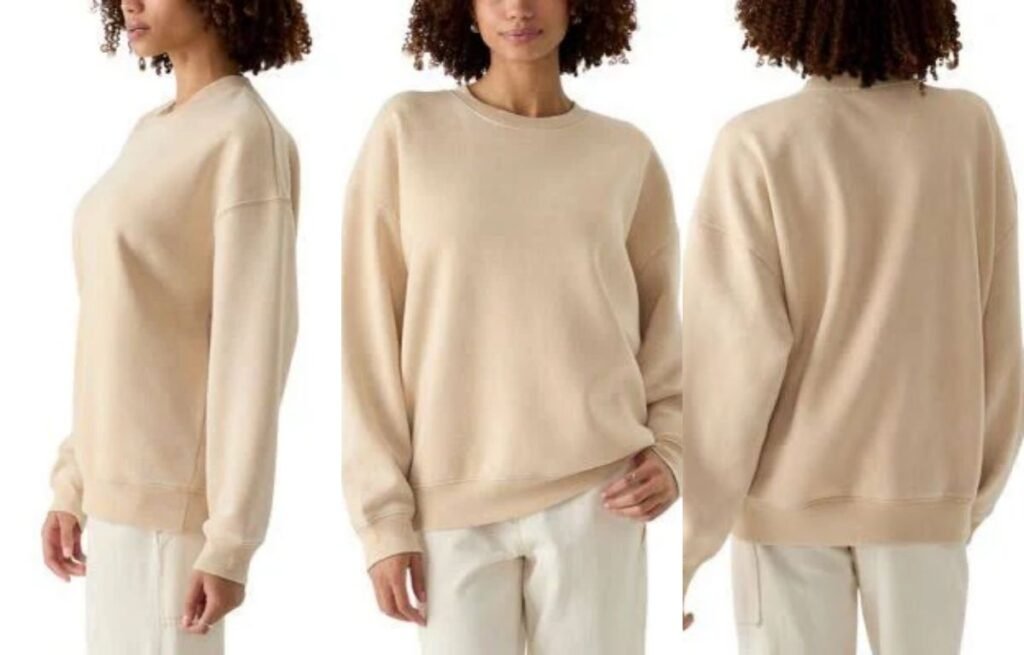
Why are drop shoulder sleeves a relaxed essential in women’s fashion design?
They create effortless style with minimal construction.
Drop shoulder sleeves are defined by a shoulder seam that falls below the natural shoulder line, creating a loose, relaxed fit. This sleeve style brings a casual, slouchy silhouette that works across seasons and body types.
I included drop shoulders in a knit sweater collection—it gave the garments a laid-back vibe that my clients loved.
How is the drop shoulder sleeve constructed differently from standard sleeves?
It’s all about the seam placement.
Unlike set-in sleeves, drop shoulder sleeves have their armhole seam placed lower on the arm, usually starting below the shoulder point. The sleeve itself is straight or slightly tapered, sewn onto a wider shoulder panel.
This design eliminates shoulder shaping, making it simple to produce and easy to wear.
Comparison table:
| Feature | Drop Shoulder Sleeve | Set-In Sleeve | Raglan Sleeve |
|---|---|---|---|
| Seam Placement | Below natural shoulder | At shoulder line | From neckline to underarm |
| Shoulder Fit | Relaxed and wide | Fitted and shaped | Diagonal, curved fit |
| Overall Look | Casual and oversized | Structured and tailored | Sporty and smooth |
What fabrics work best for drop shoulder sleeve styles?
You want flow or structure—depending on the look.
Drop shoulder sleeves can be made from both soft and structured fabrics, depending on the garment’s design. Soft knits and jersey give a drapey, relaxed look, while twill, denim, or poplin create boxy, tailored silhouettes.
For a loungewear line, I used modal jersey—the sleeve fell beautifully, without bunching or stiffness.
Recommended fabrics:
- Jersey or modal knit
- French terry or fleece
- Cotton poplin
- Denim or canvas
- Washed linen
What types of garments and customers are best suited for drop shoulder sleeves?
Ideal for comfort-focused, fashion-conscious styles.
Drop shoulder sleeves work in sweaters, T-shirts, dresses, jackets, and loungewear. They appeal to buyers who prioritize comfort and style—especially Gen Z and Millennial consumers seeking modern basics and oversized silhouettes.
They’re a must-have for collections that want effortless, wearable shape with trend appeal.
Best applications:
- Oversized knit sweaters
- Boxy T-shirts
- Minimalist shirt dresses
- Casual jackets and shackets
Straight Sleeve
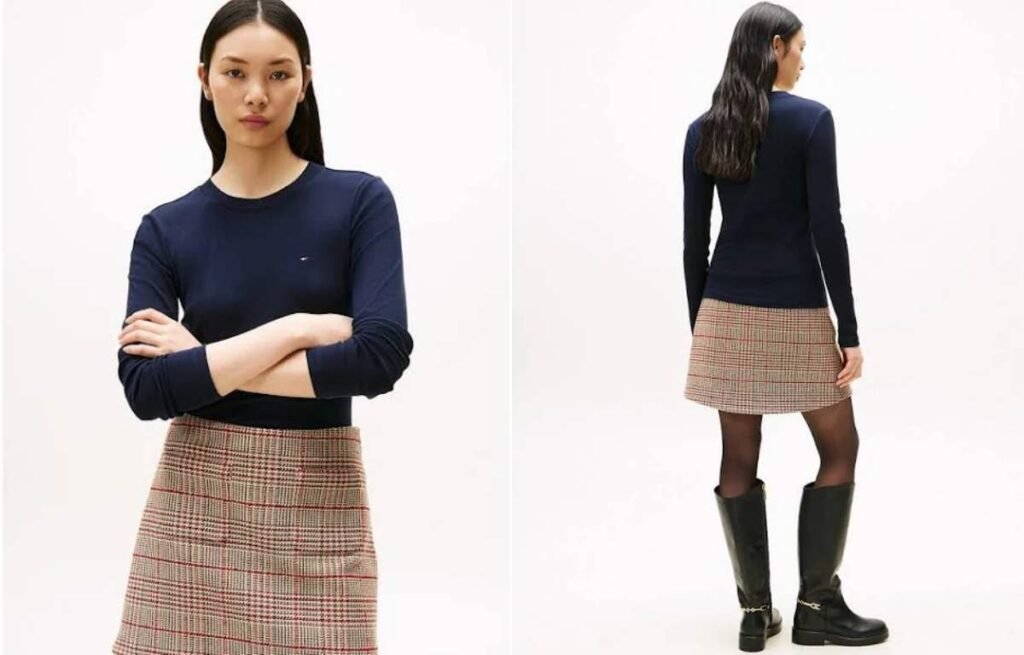
Why are straight sleeves a fundamental element in women’s fashion design?
They offer clean lines, easy construction, and timeless appeal.
Straight sleeves are cut in a simple, uniform width from the armhole to the hem. With no tapering or flaring, they deliver a sleek and balanced silhouette suitable for both casual and formal designs.
I used straight sleeves in a tailored blouse for a workwear client—the clean structure paired perfectly with sharp trousers and skirts.
How do straight sleeves differ from tapered or flared sleeve styles?
The shape stays consistent from top to bottom.
Straight sleeves maintain the same width throughout, unlike tapered sleeves that narrow toward the wrist or flared sleeves that widen. This results in a linear, structured look that complements minimalist or tailored garments.
They are often used in classic shirts, sheath dresses, and jackets where simplicity and clarity of design are key.
Shape comparison:
| Feature | Straight Sleeve | Tapered Sleeve | Flared Sleeve |
|---|---|---|---|
| Width | Uniform from top to hem | Narrows toward wrist | Widens toward cuff |
| Fit | Loose or semi-fitted | Slim and snug | Open and flowing |
| Style effect | Clean and simple | Sleek and refined | Dramatic and soft |
What fabrics suit straight sleeve designs best?
Structure or flow—it depends on the final look you want.
Straight sleeves work well with both crisp and drapey fabrics. For formalwear or workwear, cotton poplin, twill, or crepe offer sharp lines. For relaxed or resort looks, rayon, linen, or soft knits provide comfort and movement.
I’ve designed both versions: sharp, business-style sleeves in structured twill and casual ones in bamboo jersey—same cut, different vibe.
Recommended fabrics:
- Cotton poplin
- Linen
- Rayon
- Lightweight crepe
- Bamboo or modal jersey
What garments and buyers benefit most from straight sleeves?
They’re reliable, versatile, and suit every collection type.
Straight sleeves are a core choice for shirts, dresses, jackets, and knit tops. Buyers love them for their clean aesthetic and easy styling—perfect for both foundational pieces and elevated basics.
If your brand prioritizes versatility and clean design, straight sleeves should be a standard option in your pattern library.
Best applications:
- Office blouses
- Shift and sheath dresses
- Casual knitwear
- Lightweight outerwear
Oversized Sleeve
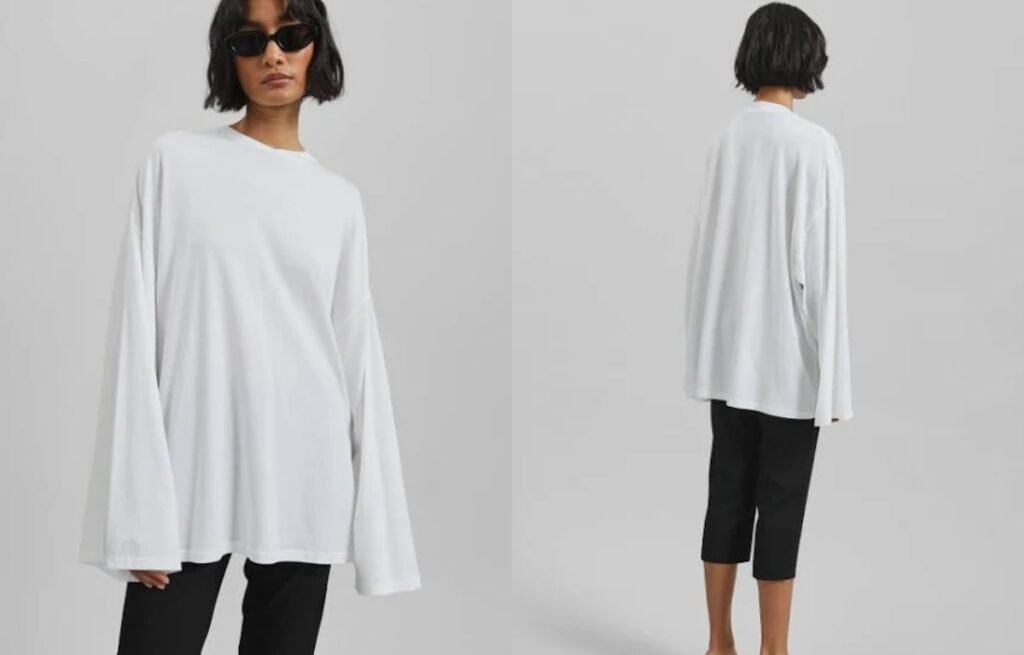
Why are oversized sleeves a bold statement in today’s fashion design?
They turn volume into visual power—and comfort into cool.
Oversized sleeves are designed to be intentionally large, with extra width or length that exaggerates the arm silhouette. This creates drama, softness, or structure depending on fabric and styling.
I once helped a client launch a winter capsule featuring oversized balloon sleeves—buyers loved the exaggerated shape paired with minimalist cuts.
How do oversized sleeves differ from loose, relaxed, or dropped sleeves?
It’s more than just extra fabric—it’s intentional volume.
Oversized sleeves are deliberately exaggerated in width or length, often with dropped shoulder seams and dramatic cuffs. Unlike relaxed sleeves, oversized ones are meant to visually dominate and reshape the silhouette.
This style is perfect for adding edge to minimalist garments or balancing narrow-waist designs.
Style comparison:
| Feature | Oversized Sleeve | Relaxed Sleeve | Dropped Shoulder Sleeve |
|---|---|---|---|
| Fit | Very loose and exaggerated | Slightly loose | Normal sleeve + low shoulder seam |
| Shape intention | Bold, dominant volume | Casual and natural | Adds width without volume |
| Statement level | High impact | Low to medium | Subtle structural change |
What fabrics best support oversized sleeve designs?
Structure or flow—both work, depending on the goal.
Structured fabrics like poplin, twill, denim, or neoprene hold exaggerated shapes well. Softer materials like viscose, rayon, or silk crepe give a draped, oversized effect without stiffness.
In a past design, I paired oversized sleeves with crisp cotton for a striking boxy silhouette that maintained its form throughout the day.
Recommended fabrics:
- Cotton poplin
- Twill or denim
- Neoprene or bonded jersey
- Silk crepe
- Viscose or rayon (for fluid versions)
What garment styles work best with oversized sleeves?
They’re made for impact—use them where it counts.
Oversized sleeves are great on statement blouses, streetwear-inspired outerwear, minimalist dresses, and even knitwear. They suit brands targeting bold, trend-conscious consumers who love fashion-forward design.
They’re also effective in balancing other oversized elements like boxy cuts or dropped waists.
Best applications:
- Balloon sleeve blouses
- Oversized shirt dresses
- Fashion sweatshirts and hoodies
- Structured coats with volume
Origami Sleeve
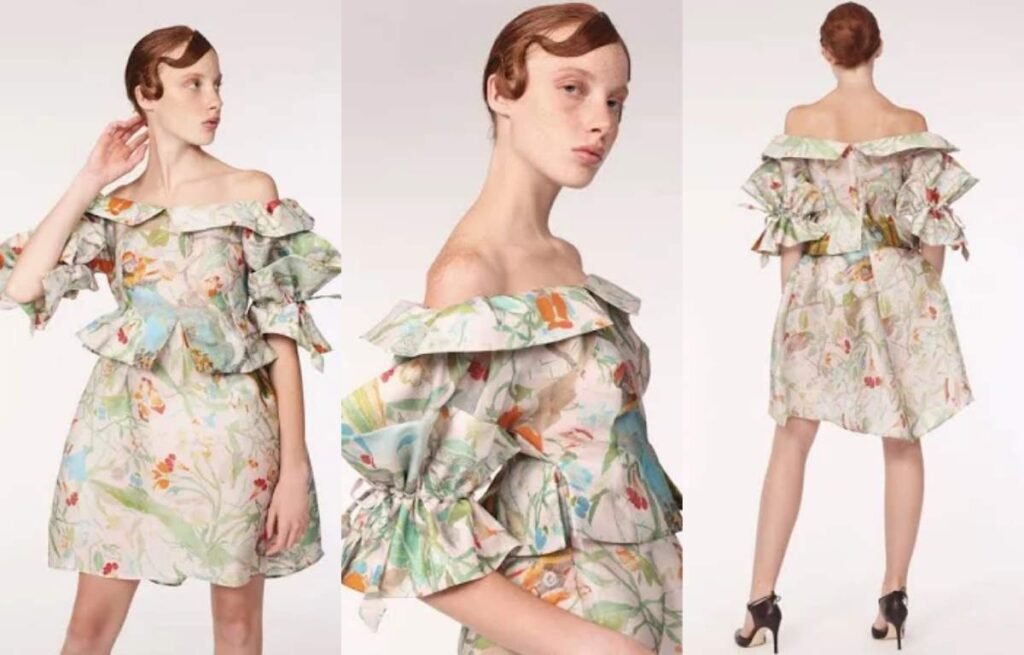
Why are origami sleeves a standout choice for avant-garde fashion in women’s design?
They bring an architectural, sculptural element to fashion that is both innovative and artistic.
Origami sleeves are inspired by the Japanese art of paper folding. The fabric is intricately pleated and folded to create geometric shapes and textures that add dimension and a structured aesthetic to the sleeve.
I once worked with a designer who wanted a high-fashion statement piece for a runway show—we used origami sleeves to add striking detail to an otherwise simple gown, and it stole the spotlight.
How do origami sleeves differ from regular pleated or gathered sleeves?
The complexity lies in the folds and angles.
Origami sleeves involve precise, engineered folds that create a 3D effect, while pleated sleeves are typically created with uniform pleats that offer texture but less complexity. Unlike gathered sleeves, which are often puffed and soft, origami sleeves are structured and crisp, almost architectural.
These sleeves are ideal for high-fashion pieces or special occasion wear, where the sleeve itself becomes the focal point of the design.
Comparison chart:
| Feature | Origami Sleeve | Pleated Sleeve | Gathered Sleeve |
|---|---|---|---|
| Construction | Precise folds and angles | Uniform pleats | Soft, gathered fullness |
| Texture | Geometric, sculptural | Textured, parallel folds | Soft, voluminous |
| Best use | Couture, high-fashion | Everyday or dressy basics | Casual, romantic styles |
What fabrics are best for creating origami sleeves?
The fabric must have enough structure to hold the folds but also enough flexibility to allow movement.
Medium to heavy-weight fabrics like satin, organza, taffeta, and silk mikado work best for origami sleeves. These fabrics hold their shape well and can showcase intricate folds without losing their form.
For one of my designs, I used duchess satin, which provided the perfect balance of structure and soft sheen, enhancing the sleeve’s sharp folds.
Recommended fabrics:
- Satin
- Organza
- Taffeta
- Silk Mikado
- Heavy cotton blends
What types of garments suit origami sleeves best?
Perfect for couture, eveningwear, and bold fashion statements.
Origami sleeves work best on dresses, tops, and outerwear designed for special occasions or high-fashion runways. They are often used in cocktail dresses, gowns, and avant-garde collections.
This style is perfect for customers looking for one-of-a-kind pieces that stand out with creative and intricate details.
Best applications:
- Couture gowns
- Avant-garde cocktail dresses
- Fashion-forward jackets or outerwear
- Statement blouses
High Puff Sleeve
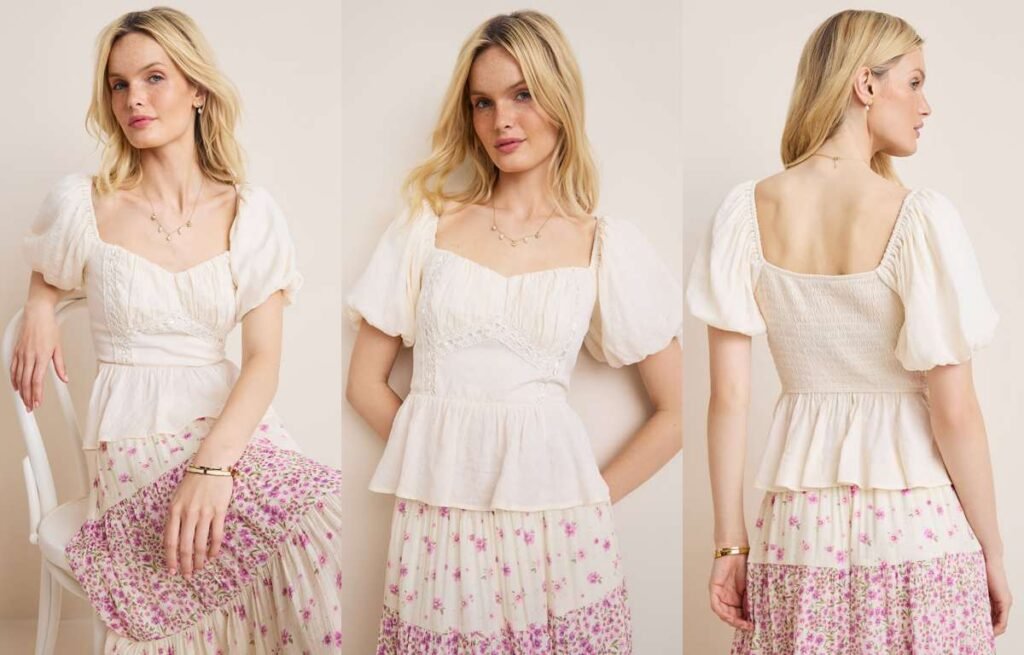
Why are high puff sleeves a bold, vintage-inspired trend in women’s fashion?
They add volume, height, and instant drama to the shoulder line.
High puff sleeves are gathered or pleated at the shoulder seam to create a raised, voluminous silhouette. Often used in statement blouses and dresses, they deliver a regal, structured look with a strong feminine touch.
I once created a puff-sleeve top for an editorial shoot—paired with a sleek body, the sleeves did all the talking.
How do high puff sleeves differ from standard puff or balloon sleeves?
It’s about placement and impact.
High puff sleeves focus the volume right at the shoulder or upper arm. They typically feature dense gathers or stiff pleats close to the shoulder seam, creating a lifted shape. In contrast, balloon sleeves puff lower, and standard puff sleeves are more rounded and soft.
This sleeve style is designed to elongate the arms and draw attention upward—great for balancing proportions.
Sleeve comparison:
| Feature | High Puff Sleeve | Puff Sleeve | Balloon Sleeve |
|---|---|---|---|
| Volume placement | Upper shoulder | Mid-sleeve | Lower sleeve |
| Visual effect | Tall, structured | Soft, rounded | Loose, exaggerated |
| Best for | Blouses, dresses, gowns | Casual and romantic tops | Streetwear, statement wear |
What fabrics best support the high puff shape?
Structure is key—soft fabrics won’t hold the form.
Crisp, medium-to-heavyweight fabrics like organza, taffeta, cotton poplin, or structured linen are best. These help maintain the sleeve’s height and definition without collapsing.
For one bridal piece, I used stiff tulle inside a silk puff sleeve to hold the volume—no extra padding needed.
Recommended fabrics:
- Organza
- Taffeta
- Cotton poplin
- Structured linen
- Silk dupioni (for formalwear)
What styles and buyers are best suited for high puff sleeves?
Ideal for fashion-forward and vintage-inspired looks.
High puff sleeves work beautifully in eveningwear, editorial dresses, and bold everyday tops. They’re perfect for buyers seeking standout silhouettes, whether for romantic, retro, or high-fashion aesthetics.
Younger audiences especially love this sleeve for its “cottagecore,” royalcore, or Y2K runway appeal.
Best applications:
- Romantic mini dresses
- Vintage-inspired blouses
- Formal gowns
- High-volume statement tops
Low Puff Sleeve

Why are low puff sleeves a soft and flattering detail in women’s fashion?
They add shape at the right spot—without overwhelming the shoulder.
Low puff sleeves are gathered or puffed around the lower arm or near the elbow, instead of the shoulder. This design creates volume and femininity while keeping the upper body sleek and structured.
I once used low puff sleeves in a linen midi dress for a boutique—it gave the dress a soft, romantic vibe that customers loved.
How are low puff sleeves constructed and how do they differ from regular puff sleeves?
It’s all about shifting the volume downward.
Unlike classic puff sleeves that gather at the shoulder, low puff sleeves keep the upper sleeve smooth and add fullness lower down—usually near the elbow or forearm. The result is a more balanced and elegant silhouette.
This design is ideal for buyers who want subtle drama and movement without adding width at the top of the arm.
Sleeve structure comparison:
| Feature | Low Puff Sleeve | Traditional Puff Sleeve | Balloon Sleeve |
|---|---|---|---|
| Puff placement | Lower arm (elbow/forearm) | Shoulder and upper arm | Full sleeve, gathered ends |
| Silhouette impact | Soft and elongated | Wide and playful | Dramatic and rounded |
| Best suited for | Refined, romantic styles | Youthful, feminine looks | Statement or editorial wear |
What fabrics work best for low puff sleeves?
You need light volume and soft fall.
Lightweight woven fabrics like cotton voile, poplin, chiffon, or soft linen are ideal. These hold gentle gathers without becoming stiff or bulky. For a more elevated finish, satin or silk crepe can also work beautifully.
I used cotton poplin with elastic casing at the elbow for one client—it gave just the right amount of puff without looking exaggerated.
Recommended fabrics:
- Cotton poplin
- Voile or muslin
- Soft linen
- Chiffon
- Silk crepe
This sleeve is especially popular among boutique buyers targeting feminine and vintage-inspired styles for modern young women.
Best applications:
- Romantic midi dresses
- Peasant-style tops
- Puff-sleeve blouses
- Soft day-to-evening dresses
Long Puff Sleeve

Why are long puff sleeves a statement-making choice in modern women’s fashion?
They add volume and romance—without sacrificing sophistication.
Long puff sleeves are full-length sleeves gathered at the shoulder and/or cuff to create volume. They add drama, vintage flair, and a bold silhouette to both casual and formal garments.
I once used long puff sleeves on a satin midi dress—the exaggerated shoulder gave it instant presence and red-carpet energy.
How do long puff sleeves differ from short puff or balloon sleeves?
The drama is in the length and structure.
Long puff sleeves extend from shoulder to wrist, with volume often concentrated at the shoulder or the entire sleeve length. Unlike balloon sleeves, which focus puff at the forearm, long puff sleeves are more regal and elongated in form.
This sleeve draws the eye upward, creating balance for lower-body-heavy silhouettes.
Sleeve comparison table:
| Feature | Long Puff Sleeve | Balloon Sleeve | Short Puff Sleeve |
|---|---|---|---|
| Length | Full length | 3/4 or wrist-length | Above the elbow |
| Volume location | Shoulder or full sleeve | Forearm or lower arm | Shoulder |
| Style impression | Dramatic and vintage | Trendy and playful | Youthful and sweet |
What fabrics work best for structured long puff sleeves?
Shape retention is key to keeping the puff.
Fabrics with a bit of body—like taffeta, organza, poplin, or crisp cotton—work well for long puff sleeves. These materials support the gathered volume without collapsing. For softer effects, try voile or crepe.
I designed one evening top in black organza—the sleeves kept their bold shape and contrasted beautifully with a fitted bodice.
Recommended fabrics:
- Taffeta
- Cotton poplin
- Organza
- Voile
- Light crepe
Best applications:
- Romantic blouses
- Satin midi dresses
- Structured jackets
- Editorial-style tops
Baby Doll Sleeve
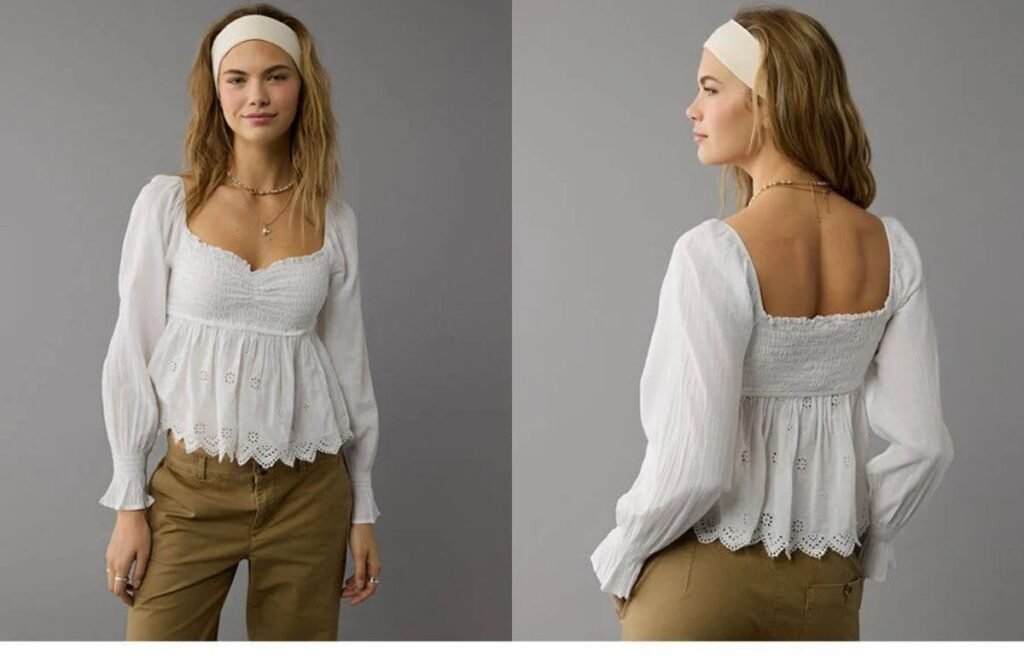
Why are baby doll sleeves a sweet and playful detail in women’s fashion design?
They instantly add softness and innocence to any garment.
Baby doll sleeves are short, puffed sleeves often gathered at the hem with elastic or a band. They create a youthful, rounded silhouette that works perfectly for romantic, vintage, or playful fashion styles.
I once designed a cotton dress with baby doll sleeves for a summer drop—the sleeves gave it a soft, retro feel that shoppers loved.
How are baby doll sleeves constructed and how do they differ from puff or cap sleeves?
It’s the length, volume, and finish that define the baby doll look.
Baby doll sleeves are typically short, round, and slightly puffed, ending just above the elbow or higher. They’re usually gathered at both the sleeve head and hem, often with elastic or a soft band, creating a curved, childlike shape.
Unlike cap sleeves, which sit flat, or puff sleeves, which can be longer and more dramatic, baby doll sleeves are smaller, rounder, and more delicate.
Sleeve comparison chart:
| Feature | Baby Doll Sleeve | Puff Sleeve | Cap Sleeve |
|---|---|---|---|
| Length | Short, above elbow | Varies (short to long) | Very short, covers shoulder |
| Shape | Rounded, childlike puff | Voluminous, lifted | Flat, minimal |
| Hem finish | Elastic or soft band | Gathered or plain | Simple curved edge |
What fabrics enhance the softness of baby doll sleeves?
Use soft and lightweight fabrics for the right drape and puff.
Cotton voile, poplin, chiffon, or soft lawn fabrics give baby doll sleeves structure without making them stiff. These materials hold shape well while staying lightweight and breathable.
For a boutique client’s romantic top, I used printed cotton voile for the baby doll sleeves—they puffed beautifully and added just the right touch of volume.
Recommended fabrics:
- Cotton voile
- Chiffon
- Poplin
- Lawn cotton
- Organza (for a dressier version)
What garments and customers are best suited for baby doll sleeve styles?
Ideal for feminine, youthful designs and seasonal collections.
Baby doll sleeves work well on babydoll dresses, romantic blouses, prairie-style tops, and retro-inspired pieces. They’re popular with Gen Z and Millennial shoppers who love vintage, soft-core, or playful aesthetics.
They’re also great for spring/summer capsules, especially in lightweight cottons or floral prints.
Best applications:
- Babydoll dresses
- Cottagecore blouses
- Smocked tops
- Vintage-style mini dresses
Drawstring Puff Sleeve

Why are drawstring puff sleeves a playful and customizable feature in women’s fashion?
They combine volume with adjustability—stylish and functional in one.
Drawstring puff sleeves are designed with internal or external drawcords that let you control the sleeve’s fullness. By adjusting the string, you can gather the fabric for a puffed look or loosen it for a more relaxed fit.
I once used this sleeve on a cotton poplin top—it let customers choose their preferred shape, and that flexibility made the piece a bestseller.
How are drawstring puff sleeves different from regular puff sleeves?
The volume is adjustable, not fixed.
Unlike traditional puff sleeves, which are permanently gathered with elastic or stitching, drawstring puff sleeves offer flexible volume through cords or ties. You can cinch them tight for dramatic puff or loosen them for a softer silhouette.
This design adds interactivity and trend appeal, especially for Gen Z and playful fashion markets.
Comparison chart:
| Feature | Drawstring Puff Sleeve | Regular Puff Sleeve | Balloon Sleeve |
|---|---|---|---|
| Volume control | Adjustable via drawcord | Fixed gathering | Fixed, large volume |
| Styling flexibility | High | Low | Medium |
| Common placement | Bicep, elbow, or full length | Shoulder and cuff | Lower arm |
What fabrics work best for drawstring puff sleeve construction?
You need both structure and softness.
Light to medium-weight woven fabrics with a bit of body—like cotton poplin, taffeta, or seersucker—hold the puff shape well when gathered. For a softer look, use rayon or crepe with internal drawstrings for subtler volume.
In one project, I used cotton seersucker with contrast drawstrings—it gave texture, playfulness, and summer appeal all at once.
Recommended fabrics:
- Cotton poplin
- Seersucker
- Rayon challis
- Light taffeta
- Crepe
What garments and fashion buyers are best suited for this sleeve style?
Best for trendy, youthful collections with interactive details.
Drawstring puff sleeves work beautifully on tops, mini dresses, and romantic blouses. They’re perfect for brands targeting Gen Z or young Millennials who enjoy adjustable silhouettes, dramatic details, and a playful fashion vibe.
They’re also ideal for spring/summer capsules or festival collections where style and function meet.
Best applications:
- Cropped drawstring tops
- Puff-sleeve mini dresses
- Romantic blouses with ruching
- Y2K-inspired separates
Cape Insert Sleeve
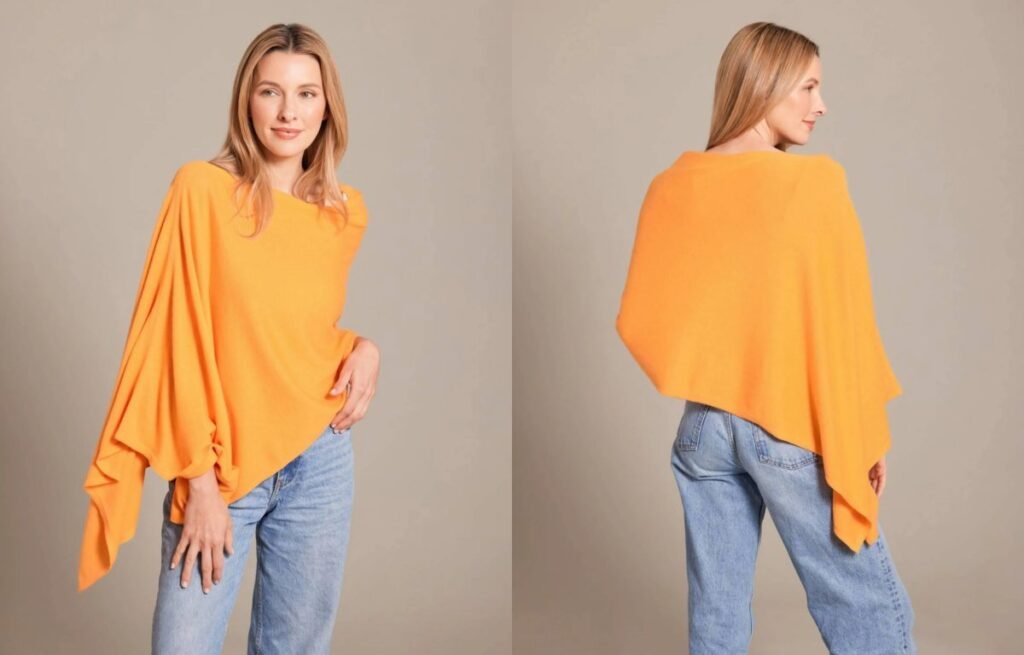
What makes the cape insert sleeve a unique fusion of drama and function in women’s fashion?
It adds flair without committing to a full cape.
Cape insert sleeves feature an extra panel of fabric sewn into the sleeve seam or armhole, creating a flowing cape-like effect while maintaining a functional sleeve underneath. They offer drama, movement, and modesty in one elegant detail.
I once designed a formal dress with chiffon cape inserts—it added visual movement and red carpet appeal without needing a full cape silhouette.
How is the cape insert sleeve constructed differently from standard cape or open sleeves?
It’s not just about adding fabric—it’s about layering intentionally.
Cape insert sleeves are built by attaching an additional fabric panel into the seam of a regular sleeve or shoulder area. This creates a semi-detached overlay that flows like a cape but allows for normal arm movement underneath.
Unlike full cape sleeves that replace the sleeve, cape inserts act as accents—making the style versatile and wearable.
Comparison breakdown:
| Feature | Cape Insert Sleeve | Full Cape Sleeve | Split Sleeve |
|---|---|---|---|
| Base structure | Regular sleeve + overlay | Cape replaces sleeve | Sleeve with front slit |
| Arm movement | Fully functional | Loosely covered | Open, dramatic |
| Design effect | Subtle drama | Bold and flowing | High motion and exposure |
What fabrics work best for cape insert sleeves?
Flow and transparency enhance the layered effect.
Sheer and lightweight fabrics like chiffon, georgette, tulle, or silk organza are best for cape inserts. These allow the overlay to float and create contrast without adding weight.
I often pair structured bodices with soft cape inserts—it’s a great balance of polish and fluidity.
Recommended fabrics:
- Chiffon
- Silk organza
- Tulle
- Georgette
- Soft netting
What garments and fashion categories benefit from cape insert sleeves?
Ideal for occasionwear and dramatic casual pieces.
Cape insert sleeves are commonly used in gowns, cocktail dresses, resort tops, and even editorial-style blouses. They’re great for buyers looking for standout details that elevate a design without making it impractical.
This sleeve style appeals to customers who want modest coverage, graceful movement, and a touch of drama.
Best applications:
- Evening dresses
- Wedding guest or bridesmaid gowns
- Statement tops for parties
- Resort kaftans with added elegance
Related Articles
The Ultimate Guide to 80+ Types of Sleeves for Women’s Fashion and Design(Part 1)
The Ultimate Guide to 80+ Types of Sleeves for Women’s Fashion and Design(Part 2)



